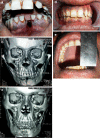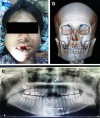Superolateral Dislocation of Bilateral Intact Mandibular Condyles: A Rare Case Series
- PMID: 28439163
- PMCID: PMC5385678
- DOI: 10.1007/s12663-016-0928-0
Superolateral Dislocation of Bilateral Intact Mandibular Condyles: A Rare Case Series
Abstract
Background and purpose: The dislocation of mandibular condyle is a clinical condition in which the head of condyle has been displaced out of the glenoid fossa. Complete dislocation of the mandibular condyle can occur in anterior, posterior, lateral and superior direction. Among these dislocations, bilateral superolateral dislocation of mandibular condyles is quite rare and often misdiagnosed. Because of its rare occurrence and unusual clinical course, the best treatment is debatable.
Patients and method: We present the first case series of true bilateral superolateral dislocation of intact mandibular condyles (Type 2B) without fracturing the Zygomatic arch, associated with symphysis fracture.
Conclusion: This article intends to provide information regarding the possible biomechanics and management of bilateral superolateral dislocation of mandibular condyles associated with symphysis fracture.
Keywords: Bilateral superolateral dislocation; Mandible fracture; Mandibular condyles.
Conflict of interest statement
Ethical Standards
All procedures performed in our study were in accordance with the ethical standards of the organization.
Informed Consent
Informed consent was obtained from all individual participants.
Figures




References
-
- American Academy of Craniomandibular Disorders . Craniomandibular disorders, guidelines for evaluation, diagnosis and management. Lombard: Quintessence Publishing Co.; 1990.
LinkOut - more resources
Full Text Sources
Other Literature Sources
